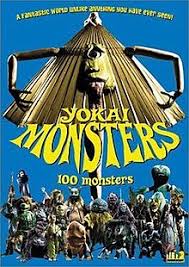
“I’m planning to do my own personal curse eliminating ritual.”
Reimon Tajimaya (Takashi Kanda) is a rich and greedy man who has just acquired an area of land that is the home of many poor people in a small Japanese village. Also on the land is a shrine. Tajimaya plans on tearing down the shrine and the tenements where the people live so he can build a brothel. He sends his head goons and some of his minions to tear down the buildings and evict the people.
The people are outraged that their homes are going to be demolished. Tajimaya doesn’t care about the people who live there. The caretaker of the shrine, Gohei (Jun Hamamura), protests the destruction of the shrine. The goons beat him up and he dies from his wounds. The goons don’t care. The village is in an uproar but since they are poor and Tajimaya has paid off the magistrate to get what he wants they are helpless to do anything about it.
The tenement use to be owned by Jinbei (Tatsuo Hanabu). Jinbei needed money for medicine for his wife and used the tenement as collateral. The medicine got so expensive that Jinbei ended up owing Tajimaya more than he could pay. To compensate for what Tajimaya says Jinbei owed he took over the tenement.
To celebrate their good fortune in acquiring the land Tajimaya has a special ceremony, a 100 Monsters ceremony. A master storyteller (Shozo Hayashiya) comes and tells ghost stories to the guests. After all the stories are told, a purification ceremony is supposed to be done to ensure that the ghosts do not actually manifest. Basically to ward of any evil curses. Tajimaya doesn’t believe in the storytellers superstitions so he decides instead to have his own purification ceremony and hands out money to his guests instead. Since a proper curse removal has not been done, the evil spirits are free to manifest themselves anyway they want and since they are evil spirits, bad things happen. But they are bad people so it’s OK.
“Yokai Monsters: One hundred Monsters” was released in 1968 and was directed by Kimiyoski Yasuda. It is a Japanese horror/fantasy film and the first of three Yokai films. A Yokai is Japanese spirit or ghost. OK, so I got distracted by something shiny. The shiny thing… monsters. The Yokai trilogy was released in 1968 and 1969. The other two movies in the series are “Yokai Monsters: Spook Warfare” 1968 and “Yokai Monsters: Along With Ghosts” 1969. The film is in Japanese with subtitles. I doubt if the subtitles are the literal translation of the Japanese. Did someone really say “Haul his ass out!” or “Whee! Getting plastered!”?
The films were produced by Daiei Film. They used practical special effects known as tokusatsu instead of stop motion. The monsters are mostly guys in suits and puppets. Some scenes also used traditional animation.
Although I didn’t see 100 monsters there were quite a few of them and some were interesting. Most notable are the umbrella monster (Kasa-obake), the no-face monster and the giant joker faced old lady monster. It’s an unusual movie that is both eerie and charming at the same time. It’s a fantasy story and a horror story told in a compelling way. It can be a little difficult to follow since some of the monster stories are intertwined with the main story.
If you’re on any hallucinogenic stuff you may not want to watch these movies.

